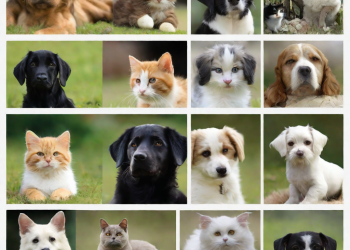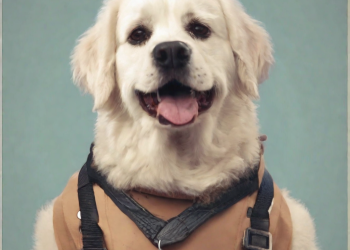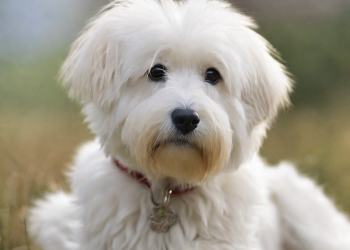Eye diseases in dogs: a growing concern in Spain
As dog lovers, we always want the best for our dogs, and that includes their eye health. Unfortunately, there are more and more cases of eye diseases in dogs in Spain. Research shows that these diseases can be prevented and treated if detected early. Therefore, it is important to pay attention to the symptoms and go to the veterinarian specialized in ophthalmology if we notice any changes in our dog’s eyes.
Eye Diseases in Dogs: A Complete Guide
Eye diseases in dogs are common and can affect your pet’s vision and quality of life. In this guide, we will show you photos of the most common diseases, their symptoms, and how to prevent them so you can take better care of your dog’s eye health.
Why is it important to know about eye diseases in dogs?
Eye health is essential for your dog’s well-being. By knowing the diseases that can affect your eyes, you will be able to identify the symptoms in time and seek appropriate treatment. Additionally, prevention is key to avoiding complications and keeping your dog happy and healthy.
dog eye anatomy
Eye health is a fundamental aspect in the lives of our canine friends, since their eyes are a vital tool for their survival and well-being. However, many times we do not give it the importance it deserves until problems appear. In Spain, an increase in cases of eye diseases in dogs has been observed, so it is important to know the anatomy of their eyes to be able to detect and treat any condition in time.
Description of the different parts of the eye and their function
A dog’s eye is made up of several structures that work together to allow them to see the world around them. Some of these parts are:
- Cornea: is the transparent layer that covers the eye and protects the internal structures.
- Iris: is the colored part of the eye that controls the amount of light that enters.
- Pupil: is the opening in the center of the iris that allows light to pass through.
- Lens: is located behind the pupil and helps focus light on the retina.
- Retina: is the light-sensitive layer that converts images into electrical signals to be sent to the brain.
Differences between the eye structure of dogs and humans
Although dog and human eyes have similar structures, there are some important differences to note. For example, dogs have a greater number of light-sensitive cells in their retina, allowing them to have sharper vision in the dark. They also have a greater number of cells in the back of the retina, which allows them to see movements better.
Another notable difference is the shape of the pupil. While in humans it is round, in dogs it can be round, oval or even slit-shaped, which allows them to have better peripheral vision.
Knowing the anatomy of the dog’s eye helps us better understand how its vision works and detect possible problems early. In the next section, we will talk about the most common eye diseases in dogs.
III. Most common eye diseases in dogs
Dogs are prone to various eye diseases throughout their lives. These can be caused by genetic factors, infections, injuries or even aging. It is important to be attentive to any changes in our dog’s eyes and go to the veterinarian if any symptoms or discomfort occur.
Common eye diseases in dogs:
- waterfalls
- Glaucoma
- Conjunctivitis
- corneal ulcers
- Entropion
- ectropion
- Dry Eye
- eye tumors
These diseases can affect any breed of dog, but some may be more common in certain breeds. For example, entropion is more common in brachycephalic breed dogs, such as the Bulldog or Pug, while glaucoma is more common in large breed dogs, such as the Cocker Spaniel or Basset Hound.
Eye diseases in dogs can be successfully treated if they are detected early and the appropriate treatment is followed. Below are some of the most common symptoms that may indicate the presence of an eye disease in our dog.
Symptoms of eye diseases in dogs:
- Redness
- excessive tearing
- Changes in eye size or shape
- Cloudiness in the cornea
- Changes in the dog’s behavior
- Eye pain or discomfort
If we notice any of these symptoms in our dog, it is important to go to the veterinarian for an accurate diagnosis. The specialist will perform a physical and eye examination, and may need to perform diagnostic tests such as tonometry and ophthalmoscopy.
It is important to highlight the importance of going to a veterinarian specialized in ophthalmology for proper diagnosis and treatment. Some eye diseases in dogs can be treated with topical and oral medications, while others may require surgery or complementary therapies such as acupuncture or homeopathy.
In addition, it is essential to follow the veterinarian’s instructions and provide the postoperative care necessary for a successful recovery.
Prevention of eye diseases in dogs:
While some eye diseases in dogs may be unavoidable, there are measures we can take to prevent them or delay their onset. Some recommendations include:
- Maintain good eye hygiene
- Provide adequate nutrition and vitamin supplements
- Avoid exposure to irritating or toxic agents
- Perform periodic checkups with the veterinarian
It is important to remember that older dogs are more prone to eye diseases, so special attention needs to be paid to their eye health. It is recommended to carry out frequent check-ups and adapt your diet and exercise according to your needs.
Special care for dogs with eye diseases:
If our dog has been diagnosed with an eye disease, it is important to take measures to ensure its well-being and avoid complications. Some special care may include:
- Adapt the environment to avoid accidents
- Use collars instead of leashes to avoid pressure on the neck
- Protect the dog from sunlight and wind
- Provide specific care according to the eye disease
In conclusion, eye health in dogs is of vital importance and we must be attentive to any changes in their eyes. With good prevention, early detection and adequate treatment, many eye diseases in dogs can be treated successfully and our furry friends will be able to enjoy good vision and quality of life.
Symptoms of eye diseases in dogs
Eye diseases in dogs can manifest themselves in different ways, so it is important to be attentive to any changes in our pet’s eyes. Some of the most common symptoms include:
- Redness in the eyes
- excessive tearing
- Changes in eye size or shape
- Cloudiness in the cornea
- Changes in the dog’s behavior, such as rubbing the eyes or avoiding light
- Eye pain or discomfort
If we notice any of these symptoms in our dog, it is important to go to the veterinarian immediately for proper diagnosis and treatment.
Diagnosis of eye diseases in dogs
To determine the presence of an eye disease in our dog, the veterinarian will perform a detailed physical and eye examination. Additionally, he may use diagnostic tests such as tonometry (to measure eye pressure) and ophthalmoscopy (to examine the inside of the eye).
It is important to go to a veterinarian specialized in ophthalmology for an accurate diagnosis and appropriate treatment.
Treatment of eye diseases in dogs
Treatment of eye diseases in dogs will depend on the type and severity of the condition. Some treatment options include:
- Topical and oral medications
- Surgery
- Complementary therapies such as acupuncture and homeopathy
- Postoperative care
It is important to follow the veterinarian’s instructions and perform periodic checkups to ensure a successful recovery.
Prevention of eye diseases in dogs
To prevent eye diseases in our dogs, we can take measures such as:
- Maintain good eye hygiene
- Provide adequate nutrition and vitamin supplements
- Avoid exposure to irritating or toxic agents
- Perform periodic checkups with the veterinarian
Special care for dogs with eye diseases
If our dog has been diagnosed with an eye disease, it is important to take measures to ensure its well-being and comfort, such as:
- Adapt the environment to avoid accidents
- Use collars instead of leashes to avoid pressure on the neck
- Protect the dog from sunlight and wind
- Provide specific care depending on the dog’s eye disease
Tips to care for the eye health of older dogs
Older dogs have a greater predisposition to eye diseases, so it is important to take special measures to care for their eye health, such as:
- Carry out frequent checks and detect problems early
- Adapt diet and exercise according to the dog’s needs
Real cases of dogs with eye diseases
To give hope to owners of dogs with eye diseases, it is important to share stories of dogs who have overcome these conditions. In addition, we can obtain advice and recommendations from owners with experience in caring for eye diseases in dogs.
V. Diagnosis of eye diseases in dogs
Early diagnosis of eye diseases in dogs is crucial for successful treatment and to avoid serious complications. Some of the methods used to diagnose these diseases include:
- Physical and eye exam: The veterinarian will examine the dog’s eyes for signs of inflammation, cloudiness, or changes in shape or size.
- Diagnostic tests: Tests such as tonometry to measure eye pressure and ophthalmoscopy to examine the inside of the eye may be performed.
- Visit a veterinarian specialized in ophthalmology: in more complex cases, a visit to a specialist in eye diseases in dogs may be recommended.
It is important to mention that eye diseases in dogs can be difficult to detect, since dogs cannot communicate their symptoms verbally. Therefore, it is essential to be attentive to any change in the behavior or appearance of our dog’s eyes and go to the veterinarian if we notice anything out of the ordinary.
Furthermore, it is important to mention that inserting the keyword “eye diseases in dogs photos” naturally in the content can help improve the visibility of this article in search engines and attract more readers interested in the topic.
SAW. Treatment of eye diseases in dogs
Eye diseases in dogs can be treated in various ways, depending on the type and severity of the condition. It is important to go to a veterinarian specialized in ophthalmology to obtain an accurate diagnosis and appropriate treatment. Some treatment options include:
Topical and oral medications
In cases of mild eye diseases, topical medications such as drops or ointments may be prescribed to relieve symptoms and treat the condition. In more severe cases, oral medications may be necessary to control inflammation and pain.
Surgery
In cases of more serious eye diseases, such as cataracts or tumors, surgery may be necessary to correct the condition. Eye surgery in dogs is a delicate procedure and should be performed by a veterinarian specialized in ophthalmology.
Complementary therapies
Some dog owners choose to use complementary therapies, such as acupuncture or homeopathy, to treat eye diseases in their pets. However, it is important to consult with a veterinarian before using any type of alternative therapy.
Postoperative care
If eye surgery is performed on your dog, it is important to follow the veterinarian’s instructions for postoperative care. This may include administering medications, properly cleaning the area, and restricting physical activity for a certain amount of time.
Prevention of eye diseases in dogs
In addition to treating existing eye diseases, it is important to take measures to prevent their appearance in our dogs. Some ways to prevent eye diseases include:
- Maintain good eye hygiene, regularly cleaning our dog’s eyes with appropriate products.
- Provide adequate food and vitamin supplements to maintain our dog’s eye health.
- Avoid exposure to irritating or toxic agents that could damage our dog’s eyes.
- Perform periodic checkups with the veterinarian to detect any eye problems in early stages.
With this preventive care, we can help maintain the eye health of our dogs and prevent the appearance of eye diseases.
Special care for dogs with eye diseases
In the event that our dog already has an eye disease, it is important to take special measures to ensure its well-being and avoid complications. Some recommendations include:
- Adapt the dog’s environment to avoid accidents that could damage its eyes.
- Use collars instead of leashes when walking your dog, as the pressure on the neck can be harmful to the eyes.
- Protect the dog from sunlight and wind, as they can irritate the eyes.
- Follow the veterinarian’s instructions for specific care according to the dog’s eye disease.
Tips to care for the eye health of older dogs
Older dogs are more predisposed to developing eye diseases, so it is important to pay special attention to their eye health. Some recommendations for caring for the eye health of older dogs include:
- Perform frequent checkups with the veterinarian to detect problems in early stages.
- Adapt food and exercise according to the needs of the dog in its old age.
- Provide vitamin supplements to maintain eye health.
Real cases of dogs with eye diseases
For those dog owners dealing with an eye disease in their pet, it can be comforting to hear stories of other dogs who have successfully overcome these conditions. Additionally, owners with experience caring for eye diseases can offer helpful advice and recommendations.
Conclusions
Eye health is of vital importance for the well-being of our dogs. With good prevention, early detection and proper treatment, we can help maintain our dogs’ eye health and ensure a happy and healthy life for them. Always remember to go to the veterinarian if you have any symptoms or changes in your dog’s eyes, and follow his recommendations for the care and treatment of eye diseases.
VII. Prevention of eye diseases in dogs
Prevention is the best way to take care of our dogs’ eye health. Some steps we can take include:
- Maintain good eye hygiene, cleaning our dog’s eyes regularly with appropriate products.
- Provide a balanced diet rich in vitamins and minerals, since adequate nutrition can help prevent eye diseases.
- Avoid exposing our dog to irritating or toxic agents, such as cigarette smoke or chemicals.
- Perform periodic checkups with the veterinarian, especially if our dog is a breed prone to eye diseases.
VIII. Special care for dogs with eye diseases
If our dog has been diagnosed with an eye disease, it is important to take some special measures to ensure its well-being:
- Adapt the environment to avoid accidents, such as placing obstacles in places where our dog can collide with its eyes.
- Use collars instead of leashes to avoid pressure on the neck, which can be especially important in cases of glaucoma.
- Protect our dog from sunlight and wind, as they can irritate his eyes.
- Follow the veterinarian’s recommendations regarding specific care according to our dog’s eye disease.
IX. Tips to care for the eye health of older dogs
Older dogs are more predisposed to developing eye diseases, so it is important to pay special attention to them:
- Perform frequent check-ups with the veterinarian and be attentive to any changes in our dog’s eyes.
- Adapt their diet and exercise according to their needs, as they may have limited vision or mobility problems.
X. Real cases of dogs with eye diseases
For those dog owners who are faced with an eye disease in their pet, it is important to remember that many of them can be treated successfully. Some tips and advice from other experienced dog owners include:
- Follow the veterinarian’s instructions and do not hesitate to seek a second opinion if necessary.
- Provide a calm and safe environment for our dog to recover after eye surgery.
- Provide a lot of love and patience to our dog during his recovery process.
XI. Conclusions
Eye health is crucial to the well-being of our dogs, and it is important to be aware of any symptoms or changes in their eyes. With good prevention, special care and appropriate medical attention, we can help our dogs maintain healthy vision and a good quality of life. Always remember to go to the vet if you have any concerns about your dog’s eye health, and don’t lose hope, as many eye diseases can be treated successfully.
Special care for dogs with eye diseases
Dogs with eye diseases require special care to ensure their well-being and prevent complications. Below are some recommendations to properly care for these dogs:
Environment adaptation
- Avoid objects or furniture that may represent a danger to the dog, especially if it has vision problems.
- Place barriers or doors to prevent the dog from accessing dangerous places.
- Avoid sudden changes in the environment that could disorient the dog.
Using collars instead of leashes
Collars are a better option for dogs with eye diseases, as they do not put pressure on the neck and may be more comfortable for them.
Protection against sunlight and wind
- Avoid exposing the dog to direct sunlight, as it can be harmful to its eyes.
- Wear dog sunglasses or keep him in shady areas when outdoors.
- Protect the dog from the wind, as it can irritate its eyes.
Specific care according to the eye disease
Depending on the eye disease the dog has, specific care may be necessary, such as:
- Apply topical ocular medications as directed by your veterinarian.
- Perform daily eye cleanings to prevent infections.
- Administer vitamin supplements to improve eye health.
It is important to follow the veterinarian’s recommendations and be attentive to any changes in the dog’s eye health. With proper care, many dogs with eye diseases can lead full and happy lives.
Tips to care for the eye health of older dogs
Older dogs are more likely to develop eye diseases, so it is important to pay special attention to their eye health. Below are some tips for caring for older dogs:
Frequent reviews
It is advisable to carry out periodic check-ups with the veterinarian to detect any eye problem in early stages and be able to treat it in time.
Adaptation of diet and exercise
Older dogs may need diet and exercise tailored to their needs, especially if they have vision problems. Consult your veterinarian to determine the best diet and exercise routine for your dog.
In summary, dogs with eye diseases require special care to ensure their well-being and prevent complications. With good eye hygiene, periodic check-ups and specific care depending on the disease, these dogs can lead a full and happy life. In addition, it is important to remember that many eye diseases can be treated successfully, so do not lose hope and always go to the veterinarian if you have any symptoms or changes in your dog’s eyes.
IX. Tips to care for the eye health of older dogs
Older dogs are more likely to develop eye diseases, so it is important to take preventative measures and be aware of any changes in their eyes. Here are some tips to take care of your older dog’s eye health:
1. Frequent reviews
It is important to take your older dog for regular checkups with the veterinarian, at least once a year. This will help detect any eye problems in early stages and take preventive or treatment measures.
2. Adaptation of diet and exercise
Older dogs may have different nutritional and exercise needs than a young dog. Consult your veterinarian about proper diet and exercise for your older dog, as this may help prevent or manage eye diseases.
3. Protection against sunlight and wind
Exposure to sunlight and wind can be harmful to the eyes of older dogs. Be sure to provide adequate shade and protection when your dog is outdoors, especially on sunny and windy days.
4. Specific care according to the eye disease
If your older dog has already been diagnosed with an eye disease, it is important to follow the specific recommendations and care indicated by your veterinarian. This may include medications, dietary changes, or special home care.
5. Greater attention to symptoms
Older dogs may have difficulty communicating discomfort or changes in their vision. Therefore, it is important to watch for any symptoms or changes in your behavior that may indicate an eye problem, such as redness, excessive tearing, or changes in the size or shape of your eyes.
6. Patience and love
Older dogs may need more time and patience to adjust to changes in their vision or treatments for eye diseases. Provide love and support during this process, and remember that many dogs with eye diseases can lead happy, fulfilling lives with proper care.
Remember that prevention and early detection are key to maintaining your older dog’s eye health. Always go to the vet if you have any concerns or changes in your dog’s eyes, and follow these tips to help keep his vision in good condition.
Eye diseases in dogs: How to take care of your best friend’s eye health
Dogs are one of the most loved and popular pets around the world. However, the importance of taking care of your eye health is often overlooked. In recent years, there has been an increase in cases of eye diseases in dogs in Spain, demonstrating the need to pay attention to this aspect of their well-being.
dog eye anatomy
To better understand eye diseases in dogs, it is important to know the anatomy of their eyes. Some key differences between dog and human eyes are:
- Dogs have more limited vision compared to humans, but they have better night vision.
- Their field of vision is wider, allowing them to see at an angle of 250 degrees.
- They have a greater number of light-sensitive cells in the retina, which allows them to detect faster movements.
Most common eye diseases in dogs
There are several eye diseases that can affect dogs, some of the most common are:
- Cataracts: opacity in the lens of the eye that can cause vision loss.
- Glaucoma: increased pressure in the eye that can damage the optic nerve and cause blindness.
- Conjunctivitis: inflammation of the membrane that covers the eye and the inside of the eyelid.
- Corneal ulcers: wounds on the cornea that can be caused by injuries or infections.
- Entropion: inward folding of the eyelid that can irritate and damage the eye.
- Ectropion: outward folding of the eyelid that can cause irritation and dryness of the eye.
- Dry eye: lack of tear production which can cause irritation and damage to the cornea.
- Eye tumors: abnormal growths in the eye that can be benign or malignant.
Symptoms of eye diseases in dogs
Some common signs of eye diseases in dogs are:
- Redness in the eye.
- Excessive tearing.
- Changes in the size or shape of the eye.
- Opacity in the cornea.
- Changes in the dog’s behavior, such as rubbing the eye or avoiding light.
- Pain or discomfort in the eye.
Diagnosis and treatment of eye diseases in dogs
If you notice any of these symptoms in your dog, it is important to go to a veterinarian specialized in ophthalmology for an accurate diagnosis. Some common tests that may be performed are:
- Physical and eye examination.
- Tonometry to measure eye pressure.
- Ophthalmoscopy to examine the inside of the eye.
Treatment will depend on the type and severity of the disease, but may include topical and oral medications, surgery, or complementary therapies such as acupuncture or homeopathy. It is important to follow the veterinarian’s instructions and provide the postoperative care necessary for a successful recovery.
Prevention and special care
Some measures you can take to prevent eye diseases in your dog are:
- Maintain good eye hygiene.
- Provide adequate nutrition and vitamin supplements.
- Avoid exposure to irritating or toxic agents.
- Perform periodic checkups with the veterinarian.
If your dog already has an eye disease, it is important to take special measures to care for his health, such as adapting his environment to avoid accidents, using collars instead of leashes to avoid pressure on the neck, protecting him from sunlight and heat. wind, and provide specific care according to its condition.
Care for older dogs
Older dogs are more predisposed to developing eye diseases, so it is important to pay attention to their eye health and have frequent checkups. You also need to adapt your diet and exercise based on your needs and limitations.
Real cases and conclusions
In this article, we have talked about the importance of taking care of dogs’ eye health, the most common diseases, their symptoms, diagnosis, treatment and prevention. We have also mentioned the importance of going to the vet if you have any symptoms or changes in your dog’s eyes. Remember that many eye diseases in dogs can be treated successfully and that, with proper care, your best friend can have a good quality of life. Don’t neglect your eye health and enjoy many years together!










